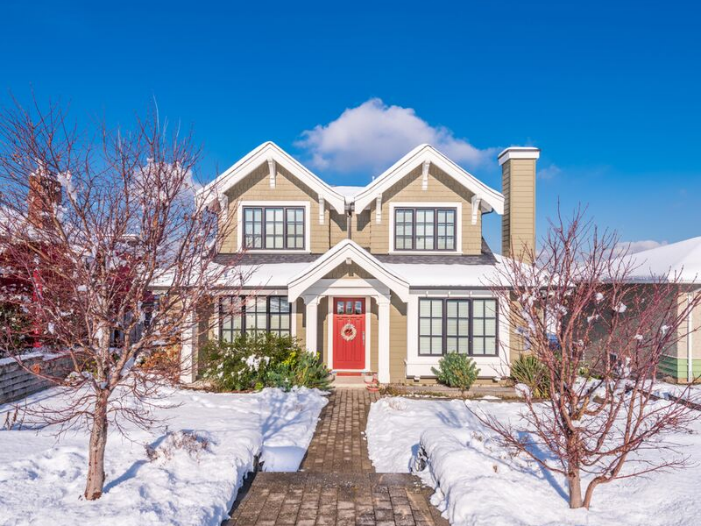
Where are interest rates headed?
This question was one of many which were addressed during our annual Market Forecast yesterday.
Our Chief Economist, Matthew Gardner, provided insight on rates, prices, inventory and many other fascinating topics.
Matthew’s prediction is for rates to creep up to 3.07% by the end of 2021. They are currently at 2.79%.
The image below shows how his prediction compares with predictions of his economist colleagues.

Please let me know if you have questions or if you would like a recording of the full presentation.


Americans spend $400 billion per year remodeling their homes.
So, which remodeling investment gives the best return when it comes to resale value?
It should come as no surprise, especially leading up to Thanksgiving, that the best money to spend upgrading your home is in the kitchen.
It’s the place where most homeowners spend most of their waking hours.
According to the research from the National Association of Realtors, it’s where remodelers will see the biggest return on investment.
Here is the ranking of various projects in terms of the value it adds to the home:
If you have questions about what your property is worth or what the best remodeling value for your home is feel free to reach out. I’m always happy to share what I’ve learned.



As the days shorten, you can mitigate many mid-winter headaches with some preemptive prep. Proper weatherizing can help protect your home from preventable damage, save money on energy costs, and, most importantly, keep you and your loved ones safe and warm throughout the winter season. Here is a useful checklist to manage your weatherization project. Setting aside some time on a couple of weekend days should be more than enough to knock this out:
Cracks & Leaks
Examine your entire house for any cracks and leaks, from your roof to your baseboards, to your basement and foundation. With unpredictable winter weather, these cracks and leaks are how the outside gets in, causing cold drafts and water damage.
Luckily, most cracks don’t require a professional to handle it. Depending on your house type and age, it’s likely you’ll be able to do it yourself with supplies from your local hardware store.
Windows & Doors:
Gaps and breaks in windows and doors is another way to let the winter in your home, and they can let heat escape, raising your heat bill throughout the season.
Make sure seals are tight and no leaks exist. If you have storm windows, make sure you put them on before the cold season begins. Additionally, add weather-strips and or a door sweep to prevent drafts and keep the heat in.
Rain Gutters:
Clean your rain gutters of any debris. In colder climates, the buildup will cause gutters to freeze with ice, crack and then leak.
Once you have removed the residue from the drains, test them by running hose water to make sure cracks and leaks have not already formed. Even in warmer locales, the buildup can put undue stress on your roof and home.
Pipes:
Protecting your pipes from freezing should be your number one priority this winter. A burst pipe can quickly become a disaster in any home.
Remember to turn off your exterior water source and take in your hose. Internally, wrapping your pipes is a recommended precaution to take.
Heating System:
Annual checks are vital in avoiding dangers such as house fires. Replace filters if you use a furnace and clear out any vents and ducts that carry heat through them. If you have baseboard heat, wipe them of dust and remove any debris that might catch fire.
Fireplace & Wood Burning Stoves:
Make sure to have chimneys and air vents cleaned early in the season if you are planning on warming your home with a wood-burning source. When your fireplace is not in use make sure to close the damper, some resources estimate an open damper can increase energy consumption by as much as 30%, increasing your bill about $200.
Outside:
Bring your patio furniture inside or cover it for the winter. Don’t forget other, smaller items such as your tools, including the hose and planting pots. Clear out any piles around the side of your house, checking for cracks and holes in your home and foundation as you go so to avoid providing shelter for unwelcome guests over the cold season.
If your property has large trees check for loose branches and call someone to trim back any limbs that may fall in your yard, on your roof or even damage a window.
Emergency Kit:
Lastly, make sure your emergency kit is up to date with provisions, batteries, fresh water, food for animals, entertainment for kids – especially if you live in an area prone to power outages.
For a more complete emergency preparedness guide, visit https://www.ready.gov/winter-weather.

For the 14th time this year, 30-year mortgage rates set a record and hit an all-time low.
Based on data just released by Freddie Mac, rates are now at 2.71%. Their weekly survey of the 30-year mortgage rate dates back to 1971.
Just one year ago rates were at 3.68%.
So, what does this mean for buyers?
Based on a $400,000 loan, current rates result in a monthly payment that would be $212 less than one year ago.

In this episode Windermere Chief Economist Matthew Gardner dives into three of the latest housing market data releases and gives context to their historical significance.


Now that we’ve made it through the 3rd Quarter of 2020 it’s time to look back and see how Troutman Park’s Real Estate market has performed compared to other recent years. Earlier in the year many felt like property values would decline like so many other investments did through all the Covid-19 adjustments. If you own a home in the Troutman Park area you’ll probably be happy to see that we’ve actually fared quite well though.
In Northern Colorado we typically see the market take a little bit of a seasonal breather during the 3rd quarter of the year as families put their home search on pause to get ready for back to school. This year has been a little different though as we saw our neighborhood’s real estate sales accelerate significantly from July through September.
Here are the numbers compared to the 3rd Quarter of recent years:
2020 Q3 – 27 homes sold for $11,109,356. They ranged from $340,200-$480,000 at an average of $411,457
2019 Q3 – 19 homes sold for $7,555,400. They ranged from $300,000-$494,500 at an average of $397,652
2018 Q3 – 17 homes sold for $6,043,650. They ranged from $290,000-$449,500 at an average of $355,508
2017 Q3 – 18 homes sold for $6,290,750. They ranged from $296,000-$429,900 at an average of $349,486
2016 Q3 – 19 homes sold for $6,288,000. They ranged from $260,000-$405,000 at an average of $330,947
It is noteworthy to point out that the 1st two Quarters of 2020 only saw 2 more sales in our neighborhood than the 3rd Quarter!
If you have questions about Real Estate I’m always happy to share what I know. I grew up here in Fort Collins, I’ve worked in Real Estate since 2002 and live right here in Troutman Park so feel free to reach out if you ever have questions.


We just completed a review of the September numbers in our market.
Here is the one number that is standing out to us – average price.
Prices are way up over last year. Here are the specific average price increases in each of our markets compared to September 2019:
This change in prices has of course generated questions from our clients.
To help our clients answer questions about prices and other real estate topics, we have set up a private online event with our Chief Economist Matthew Gardner.
The event is set for Tuesday from 9:00 to 10:00.
Here is the registration link: https://attendee.gotowebinar.com/register/6400354351666419467
Matthew will be addressing these questions as well as many others:
This online event is for the clients and friends of Windermere. If you would like more information feel free to reach out!



Image Source: Canva
When it comes time to sell your home, first impressions are crucial. Improving your curb appeal helps to make the most of a buyer’s first glance and sets the stage for their interest in purchasing your home. The following projects are simple and inexpensive ways to enhance both your home’s first impression and its value.
Landscaping

Image Source: Canva
Porch
Front porches set the stage for all your home has to offer. Improvements here will play a significant role in how comfortable potential buyers feel about the property and how inspired they are to explore the inside of the house.
Other
These miscellaneous projects will add the finishing touches to your home’s curb appeal and get it in prime selling condition.
If you have particular questions about your property feel free to ask me what you can do to improve your home’s value and curb appeal. I’m always happy to share what I’ve learned.



Image Source: Shutterstock
For some home buyers, a fixer-upper is their idea of a dream home. Preparing for the process comes down to creating a plan, knowing what to look for, and understanding what financing options are available.
Create a plan
Fixer-uppers require a future-oriented mindset. Knowing the magnitude of the project you and your household are willing to take on will help dictate your budget and expectations as time goes on. Understand that in addition to the down payment and closing fees, the costs inherent in a fixer-upper purchase have the potential to go over-budget easily. Familiarize yourself with permitting in your area to understand how to navigate any legal roadblocks in the renovation process.
What to look for
Location: Whether you are purchasing a fixer-upper with plans to sell it, rent it out, or live in it, consider its location before purchasing. If you’re planning on selling or renting, location is one of the most important factors to making a return on your investment. And if you’re planning to live in your fixer-upper, keep in mind that location will be a large part of your experience in the home.
Scope of renovation: If you are looking for a smaller scale renovation, look for fixer-uppers that require cosmetic projects like new interior and exterior paint, fresh carpeting and flooring, appliance upgrades, and basic landscaping maintenance. More expensive and involved projects include reroofing, replacing plumbing and sewer lines, replacing HVAC systems, and full-scale room remodels.
Inspections: Beyond a standard home inspection, which covers components of the home like its plumbing and foundation, consider specialized inspections for pests, roof certifications, and engineering reports. This will help differentiate between the property’s minor flaws and critical problems, further informing your decision when it comes time to prepare an offer.
Financing options
Renovation loans allow buyers to finance the home and the improvements to the home together. Extra consultations, inspections, and appraisals are often required in the loan process, but they help guide the work—and thereby, added value—of your fixer-upper. Talk with your lender about which option is best for you.



The following analysis of the Metro Denver & Northern Colorado real estate market is provided by Windermere Real Estate Chief Economist Matthew Gardner. We hope that this information may assist you with making better-informed real estate decisions. For further information about the housing market in your area, please don’t hesitate to contact your Windermere agent.
ECONOMIC OVERVIEW
COVID-19 had significant negative impacts on employment in Colorado. The pandemic caused the loss of over 342,000 jobs in March and April as unemployment rose to 12.2%. For comparison, peak unemployment following the Great Recession was 8.9%. However, it appears as if the massive contraction in employment is behind us (at least for now). Employment in Colorado rose in May by 68,800 jobs, a monthly increase of 2.8%, pushing the unemployment rate down to 10.2%. Regionally, the Denver metro area added 18,600 jobs in May and the Fort Collins metro area added 3,500 jobs. It is certainly too early to say that we are out of the woods, but we seem to be headed in a positive direction. Colorado’s COVID-19 infection rates started increasing again in June, which could slow down the economic recovery. However, I do not believe that it is likely to have any substantial impact on the housing market.
HOME SALES

HOME PRICES

DAYS ON MARKET

CONCLUSIONS
 This speedometer reflects the state of the region’s real estate market using housing inventory, price gains, home sales, interest rates, and larger economic factors.
This speedometer reflects the state of the region’s real estate market using housing inventory, price gains, home sales, interest rates, and larger economic factors.
Demand appears to be returning, which—combined with historically low interest rates—should lead to a brisk summer housing market. Assuming that the state gets new infection rates under control, I do not see why the housing market wouldn’t perform well this summer. As such, I have moved the needle just a little more in favor of home sellers.